Creating an outdoor kitchen with a pizza oven transforms your backyard into a culinary paradise. This comprehensive guide walks you through every step of building your dream outdoor cooking space—from initial planning to the finishing touches. Whether you’re considering a wood-fired brick oven or a modern gas-powered unit, we’ll help you navigate the entire process to create an outdoor kitchen that’s both functional and beautiful.
With the right approach, your outdoor kitchen can become the heart of your home’s exterior, perfect for entertaining guests or enjoying quiet family dinners under the stars. Let’s explore how to bring your vision to life with practical advice for every stage of the project.
Planning Your Outdoor Kitchen with Pizza Oven
Before breaking ground on your outdoor kitchen project, proper planning is essential. This foundation stage will determine the success of your entire build and help avoid costly mistakes.
Assessing Your Space
Start by evaluating your available outdoor area. Measure the dimensions and note any existing features like trees, slopes, or utilities. Consider sun exposure, wind patterns, and views from your house. An ideal location provides some shelter from extreme weather while remaining well-ventilated for smoke from your wood-fired pizza oven.
For a functional outdoor kitchen with a pizza oven, you’ll need at minimum:
- 150-200 square feet of usable space
- Level ground or the ability to create a level foundation
- Proper clearance from combustible structures (typically 10+ feet)
- Access to utilities (water, gas, electricity)
- Proximity to your indoor kitchen for convenience
Understanding Building Codes and Permits
Local regulations often govern outdoor kitchen installations, especially those involving gas lines or permanent structures. Before proceeding:
- Contact your local building department about permit requirements
- Check homeowners association rules if applicable
- Verify setback requirements (distance from property lines)
- Understand fire safety codes specific to outdoor ovens
- Confirm if inspections will be needed during construction
Setting a Realistic Budget
Outdoor kitchens with pizza ovens can range widely in cost depending on size, materials, and features. Create a detailed budget that accounts for:
Essential Costs
- Foundation and structural elements
- Pizza oven (prefabricated or materials for DIY)
- Countertops and cabinetry
- Utility connections (gas, water, electric)
- Ventilation system or chimney
Additional Considerations
- Seating area and furniture
- Lighting fixtures
- Weatherproofing elements
- Landscaping around the kitchen
- Professional design or installation fees
Not Sure Where to Start?
Take our quick assessment to determine the best pizza oven type for your outdoor kitchen needs, space, and budget.
Designing Your Outdoor Kitchen Layout
The layout of your outdoor kitchen significantly impacts its functionality and flow. When designing around a pizza oven as the centerpiece, consider how you’ll move between preparation, cooking, and serving areas.
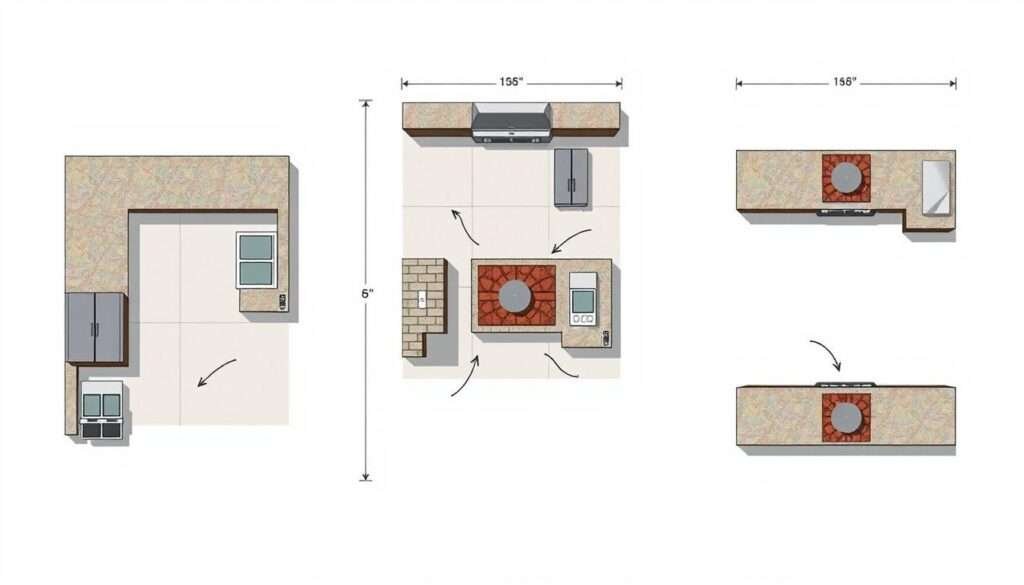
Popular Outdoor Kitchen Layouts
L-Shaped Layout
Perfect for corner spaces, this design provides separate zones for preparation and cooking while keeping everything within reach. The pizza oven typically sits at the corner junction or along one wing.
- Efficient use of corner space
- Good workflow between zones
- Allows for separate prep and cooking areas
U-Shaped Layout
Ideal for larger spaces, this configuration surrounds the cook with countertops and appliances. The pizza oven often becomes the focal point at the center of the back wall.
- Maximum counter space
- Everything within arm’s reach
- Creates a defined outdoor room feel
Linear Layout
Perfect for narrow spaces or along a wall, this straightforward design places all elements in a row. The pizza oven typically anchors one end of the line.
- Space-efficient for smaller yards
- Simplifies utility connections
- Can be expanded later if needed
Positioning Your Pizza Oven
The pizza oven should be a focal point of your outdoor kitchen while also being practical to use. Consider these placement factors:
- Ventilation needs (smoke must have a clear path away from seating)
- Wind direction (prevent smoke from blowing into your house)
- Visual impact (make it a showcase element)
- Proximity to prep areas (minimize walking distance)
- Safety clearances from combustible materials

Work Zones for Efficient Cooking
Just like indoor kitchens, your outdoor space should incorporate distinct work zones:
Preparation Zone
Include ample counter space (at least 24 inches) near the pizza oven for assembling pizzas. Consider a lower counter height for comfortable dough rolling.
Cooking Zone
Center this around your pizza oven, with space for tools, wood storage (if applicable), and possibly additional cooking appliances like a grill or burners.
Serving Zone
Create a dedicated area where cooked pizzas can be cut, plated, and garnished before serving to guests.
Cleanup Zone
If possible, include a sink with running water to make cleanup easier and more likely to happen promptly.
Need Help With Your Layout?
Download our free outdoor kitchen layout templates with pizza oven placement options for different yard sizes and shapes.
Selecting Materials for Your Outdoor Kitchen
Choosing the right materials for your outdoor kitchen with pizza oven is crucial for longevity, maintenance, and aesthetics. Since these spaces face harsh weather conditions, prioritize durability while maintaining your desired look.
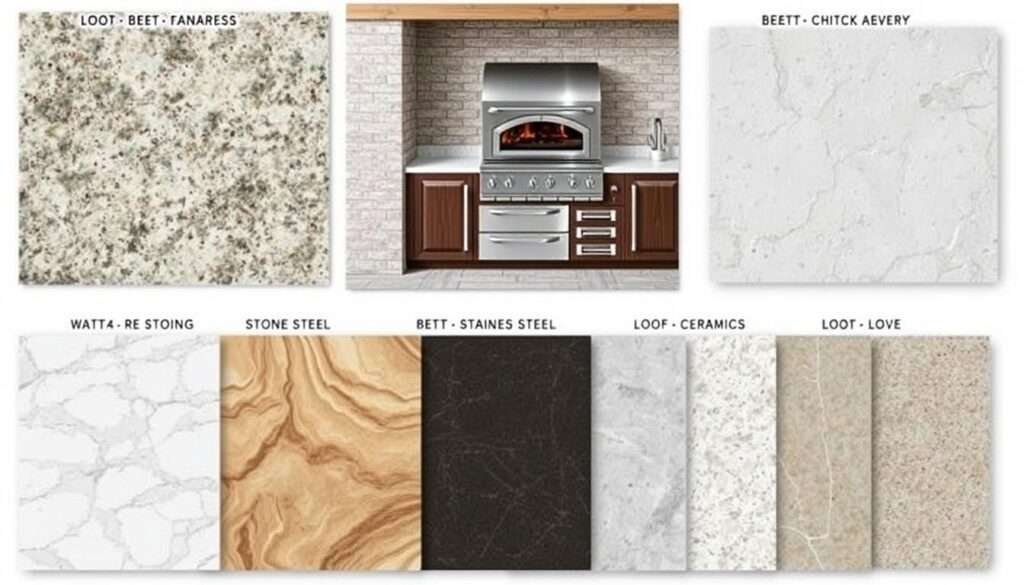
Weather-Resistant Countertops
Your countertops need to withstand temperature fluctuations, moisture, and UV exposure while providing a functional work surface.
Natural Stone
Options like granite and soapstone offer excellent heat resistance—ideal near pizza ovens. Look for darker colors that won’t show staining as easily.
- Extremely durable
- Heat resistant
- Each piece is unique
- Requires periodic sealing
Concrete
Custom-poured concrete countertops can be formed to any shape and stained to match your aesthetic. They’re particularly good for creating seamless surfaces.
- Highly customizable
- Can incorporate special features
- Moderate cost
- Requires proper sealing
Porcelain/Ceramic Tile
Tile offers endless design possibilities and excellent heat resistance. Choose frost-resistant, exterior-grade tiles with appropriate grout.
- Heat and stain resistant
- Wide variety of designs
- Can be replaced in sections
- Grout requires maintenance
Durable Cabinetry Options
Outdoor cabinetry must withstand moisture and temperature changes without warping or deteriorating.
Stainless Steel
The gold standard for outdoor kitchens, 304-grade stainless steel resists corrosion and can handle any weather. Look for marine-grade options in coastal areas.
- Virtually maintenance-free
- Won’t rot, warp, or harbor mold
- Matches most appliances
- Can get hot in direct sun
Marine-Grade Polymer
These high-performance plastic cabinets won’t rot, crack, or fade. They’re available in various colors and can mimic the look of painted wood.
- 100% waterproof
- No painting required
- UV-resistant
- Limited design options
Masonry
Built-in stone, brick, or concrete block structures offer permanence and can be finished with stucco or stone veneer to match your pizza oven.
- Extremely durable
- Can support heavy countertops
- Matches traditional pizza ovens
- Limited storage functionality
Weather-Resistant Wood
If you prefer wood, choose teak, ipe, or marine-grade plywood with quality exterior finishes. These require more maintenance but offer warmth and character.
- Natural aesthetic
- Can be refinished
- Typically less expensive
- Requires regular maintenance
Flooring Considerations
Your outdoor kitchen flooring needs to be non-slip, durable, and able to withstand food spills and weather exposure.
- Concrete: Stamped or stained for aesthetic appeal, sealed for stain resistance
- Pavers: Available in various materials and patterns, allows for drainage
- Porcelain Tile: Choose exterior-rated, textured tiles with high slip resistance
- Natural Stone: Options like travertine or slate offer beauty and durability
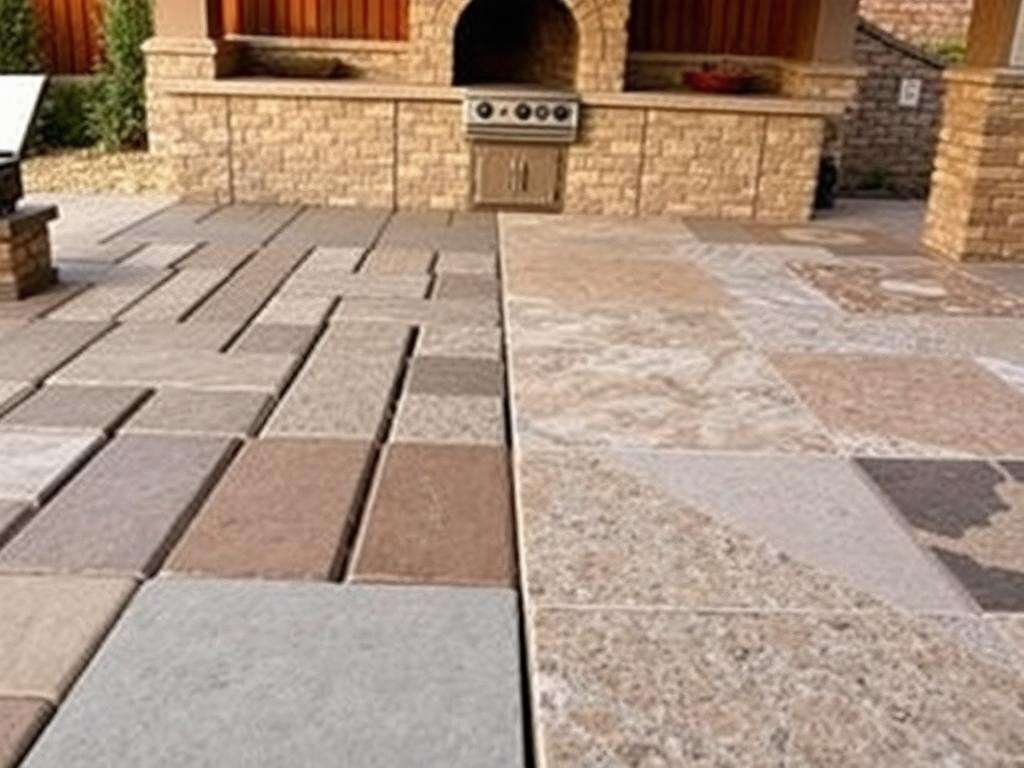
Material Selection Made Easy
Download our comprehensive material comparison chart to find the perfect weather-resistant options for your climate and budget.
Pizza Oven Installation Guide
The pizza oven is the heart of your outdoor kitchen. Whether you choose a prefabricated unit or build a custom masonry oven, proper installation is crucial for safety, performance, and longevity.
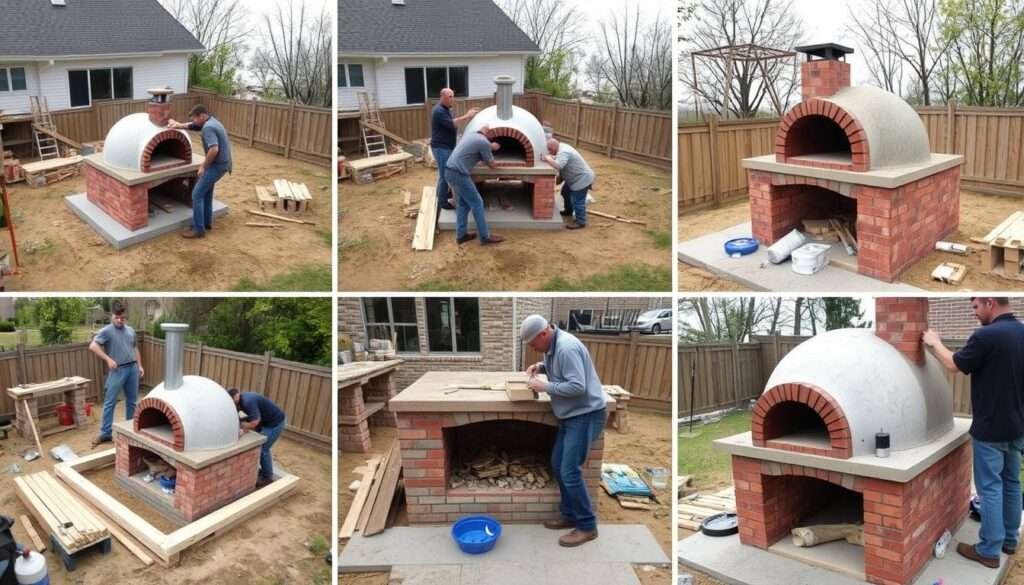
Choosing Between Prefabricated and DIY Masonry Ovens
Prefabricated Pizza Ovens
- Faster installation (often 1-2 days)
- Consistent performance
- Available in various fuel types (wood, gas, hybrid)
- Many include warranties
- Can be moved if needed
DIY Masonry Ovens
- Fully customizable size and appearance
- Often better heat retention
- Can be integrated perfectly with your design
- Potentially lower material costs
- Satisfaction of building it yourself
Wood-Fired vs. Gas Pizza Oven Installation
Wood-Fired Oven Considerations
Traditional wood-fired ovens require:
- Proper foundation to support significant weight
- Chimney or flue system for smoke ventilation
- Clearance from combustible materials
- Wood storage area nearby
- Insulation layer to maintain cooking temperatures
Gas Oven Considerations
Modern gas-powered pizza ovens require:
- Professional gas line installation
- Proper ventilation (though less than wood)
- Access to electrical outlet for ignition systems
- Compliance with local gas codes
- Consideration of propane tank placement (if not using natural gas)
Step-by-Step Installation Process

For Prefabricated Ovens:
- Prepare the base: Ensure you have a level, sturdy surface that can support the oven’s weight (typically 500-1000 pounds). This could be a reinforced countertop, steel stand, or masonry base.
- Check clearances: Verify that your installation location maintains proper clearances from combustible materials (usually 2-3 feet on all sides).
- Position the oven: With adequate help (at least 3-4 people), carefully place the oven on its base. Some units come in multiple pieces that assemble on-site.
- Connect utilities: For gas ovens, have a licensed professional connect the gas line. For electric ignition systems, ensure proper wiring.
- Install chimney/vent: Follow manufacturer instructions to install the chimney pipe or ventilation system.
- Finish surroundings: Complete any decorative finishes around the oven, such as stone veneer, tile, or stucco.
For DIY Masonry Ovens:
- Build a reinforced foundation: Create a concrete slab that can support 2000+ pounds, with proper footings that extend below the frost line.
- Construct the base: Build up the base using concrete blocks, bricks, or stone to your desired height (typically 36-42 inches).
- Install insulation layer: Place a layer of insulation board on top of the base to prevent heat loss.
- Create the cooking floor: Lay firebricks in a level pattern using refractory mortar.
- Build the dome: Using firebricks or a form, create the dome shape following your plans or kit instructions.
- Add insulation layer: Cover the dome with ceramic fiber insulation and refractory cement.
- Install chimney: Add the flue and chimney system at the appropriate location.
- Apply finish layer: Cover with a weather-resistant finish like stucco, tile, or stone veneer.
- Cure the oven: Follow a gradual curing process with small fires over several days to remove moisture safely.
Pro Tip: For masonry ovens, the cooking floor should be at least 2.5 inches thick using firebricks laid flat. This mass is crucial for maintaining consistent cooking temperatures and heat retention.
Need Professional Installation Help?
Our network of certified outdoor kitchen installers specializes in pizza oven installation. Get a free consultation to discuss your project.
Setting Up Utilities for Your Outdoor Kitchen
Proper utility connections are essential for a functional outdoor kitchen with pizza oven. Planning these elements early in your project will prevent costly modifications later.

Gas Line Installation
If you’re installing a gas-powered pizza oven or other gas appliances, proper gas line installation is critical for safety.
Important Safety Notice: Gas line installation should always be performed by a licensed professional who understands local codes and proper safety protocols. Improper gas installations can lead to dangerous leaks.
- Determine whether you’ll use natural gas or propane
- Calculate the total BTU requirements for all appliances
- Ensure proper pipe sizing to deliver adequate gas volume
- Install shutoff valves at accessible locations
- Consider flexible connections to accommodate movement
- Plan for pressure testing before first use
Electrical Requirements
Even outdoor kitchens centered around wood-fired pizza ovens benefit from electrical connections for lighting, refrigeration, or electric ignition systems.
- Install GFCI (ground fault circuit interrupter) outlets for safety
- Use weather-resistant covers for all outlets and switches
- Plan for adequate lighting around cooking and prep areas
- Consider dedicated circuits for high-draw appliances
- Use outdoor-rated, waterproof electrical boxes
- Bury conduit at appropriate depth per local code
Water Supply and Drainage
A sink in your outdoor kitchen makes cleanup much easier and more convenient.
Water Supply Options
- Extend existing home plumbing with frost-proof lines
- Install frost-free hose bibs with shutoff valves
- Consider hot water needs (tankless heater options)
- Use quick-disconnect fittings for winterization
Drainage Solutions
- Connect to home sewer system where permitted
- Install a dry well for gray water (check local codes)
- Consider a French drain system for runoff
- Ensure proper slope for drainage (¼ inch per foot)
Ventilation Considerations
Proper ventilation is crucial, especially for wood-fired pizza ovens that produce smoke and high heat.
- Install a chimney that extends at least 2 feet above nearby roof structures
- Consider prevailing wind direction to prevent smoke blowback
- For covered areas, install a hood system with proper CFM rating
- Ensure adequate clearance around the oven for air circulation
- Check local codes for specific ventilation requirements
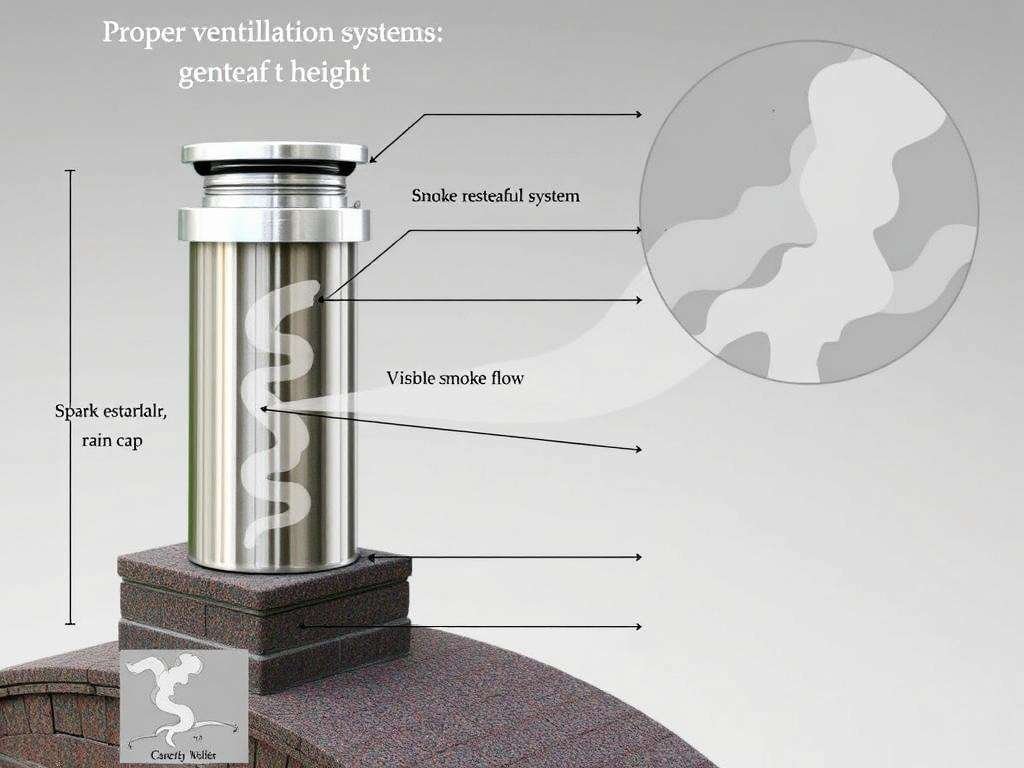
Utility Planning Assistance
Download our utility planning worksheet to ensure you’ve covered all the essential connections for your outdoor kitchen with pizza oven.
Finishing Touches for Your Outdoor Kitchen
The final details transform your outdoor kitchen with pizza oven from a cooking space into an inviting outdoor living area. These elements enhance both functionality and aesthetics.

Creating Comfortable Seating Areas
Thoughtful seating arrangements encourage guests to linger while you prepare delicious wood-fired meals.
- Bar-height counters: Allow guests to sit and chat with the cook
- Dining tables: Position within view of the pizza oven for entertainment value
- Lounge seating: Create a transition zone between cooking and relaxation areas
- Built-in benches: Can incorporate storage and define the space
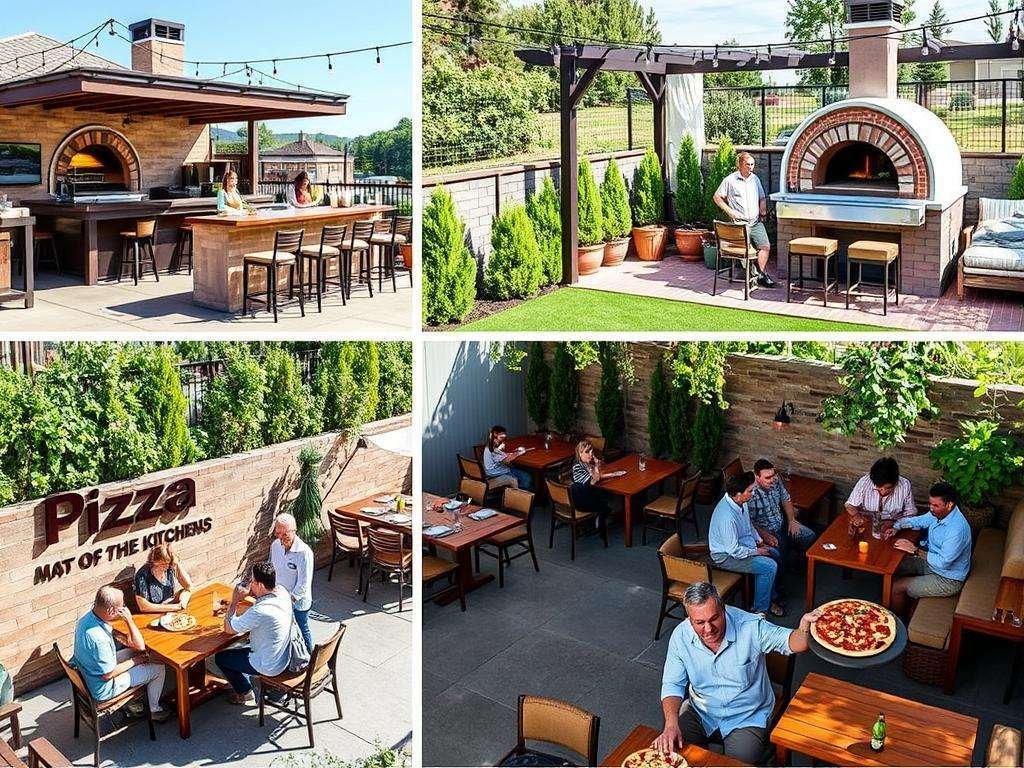
Lighting for Ambiance and Functionality
Well-planned lighting extends the usability of your outdoor kitchen into the evening hours while creating atmosphere.
Task Lighting
Ensure cooking and prep areas are well-illuminated for safety and functionality.
- Under-cabinet LED strips
- Adjustable spotlights
- Overhead pendant lights
Ambient Lighting
Create overall illumination and mood for the entire space.
- String lights or bistro lights
- Recessed perimeter lighting
- Lanterns or torches
Accent Lighting
Highlight architectural features and add visual interest.
- Uplights on the pizza oven
- Step lights for safety
- Illuminated planters
Weather Protection Options
Extending your outdoor kitchen season requires some form of weather protection.
- Pergolas: Provide partial shade while maintaining airflow for smoke
- Pavilions: Offer full roof coverage while remaining open on the sides
- Retractable awnings: Provide flexibility for different weather conditions
- Umbrellas: Affordable, movable options for targeted shade
Decorative Elements and Accessories
Personal touches make your outdoor kitchen with pizza oven uniquely yours.
Functional Décor
- Herb garden near prep areas
- Decorative wood storage for pizza oven
- Custom pizza peel display
- Attractive storage containers
Aesthetic Elements
- Weather-resistant artwork
- Outdoor-rated rugs to define spaces
- Decorative tile accents
- Potted plants and greenery
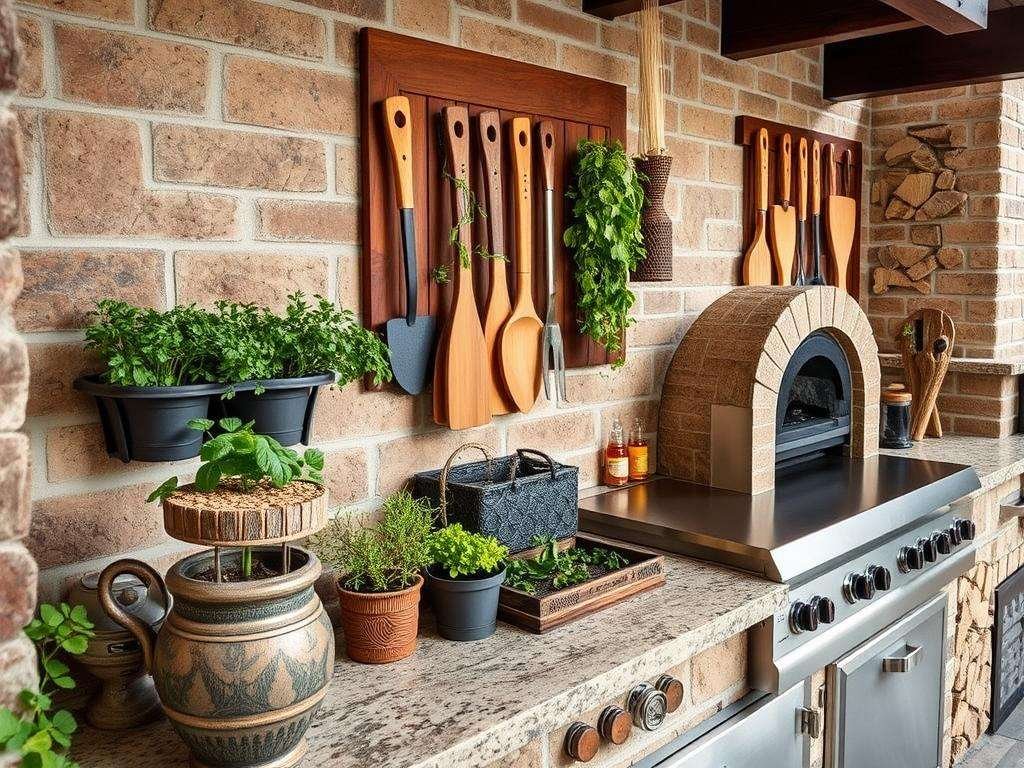
Design Inspiration Gallery
Browse our collection of finished outdoor kitchen projects with pizza ovens to spark ideas for your own space.
Safety and Maintenance for Your Outdoor Kitchen
Proper safety measures and regular maintenance ensure your outdoor kitchen with pizza oven remains safe, functional, and beautiful for years to come.
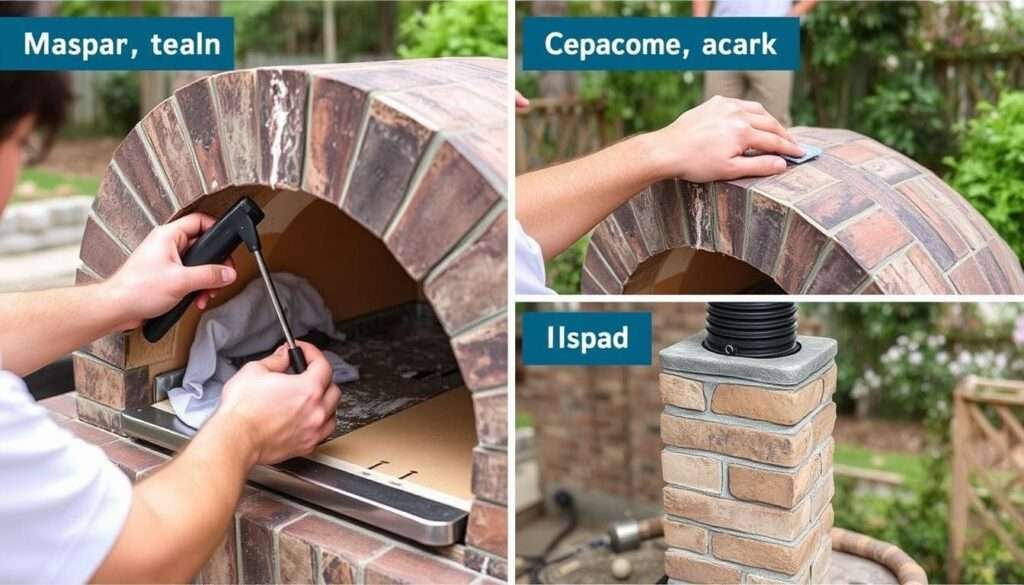
Fire Safety Essentials
Wood-fired pizza ovens introduce open flames to your outdoor space, making fire safety a top priority.
- Install a fire extinguisher rated for grease fires within easy reach
- Maintain proper clearances from combustible materials
- Consider a spark arrestor for wood-fired oven chimneys
- Keep a bucket of sand nearby for emergency fire control
- Never leave fires unattended in your pizza oven
- Allow ashes to cool completely before disposal in metal containers
Weatherproofing Your Outdoor Kitchen
Protecting your investment from the elements extends its lifespan and reduces maintenance.
Seasonal Preparation
- Cover pizza oven when not in use
- Winterize water lines before freezing temperatures
- Apply appropriate sealants to countertops annually
- Check for and repair grout or mortar cracks
Material Protection
- Use marine-grade covers for appliances
- Apply UV protectant to susceptible surfaces
- Ensure proper drainage away from structures
- Consider removable panels for extreme weather
Pizza Oven Maintenance Schedule
Regular care keeps your pizza oven performing at its best while preventing safety issues.
| Maintenance Task | Frequency | Instructions |
| Ash removal | After each use | Allow ashes to cool completely, then remove with metal scoop into metal container |
| Cooking surface cleaning | After each use | Brush cooking surface with oven brush; avoid water on hot surfaces |
| Chimney inspection | Monthly | Check for creosote buildup and clean as needed with chimney brush |
| Exterior cleaning | Monthly | Wipe down with appropriate cleaner for your finish material |
| Gas connection check | Bi-annually | Inspect hoses and connections for leaks using soapy water solution |
| Deep cleaning | Annually | Remove all debris, check for cracks, repair as needed |
Seasonal Care Tips
Spring
- Inspect for winter damage
- Clean and reconnect water lines
- Check gas connections
- Apply fresh sealants as needed
Summer
- Clean cooking surfaces regularly
- Check for insect nests
- Inspect electrical connections
- Touch up finishes as needed
Fall/Winter
- Winterize water lines
- Cover appliances and furniture
- Clean chimney before storage
- Secure loose items before storms
Pro Tip: Create a maintenance calendar with reminders for seasonal tasks. Regular small maintenance prevents costly repairs and extends the life of your outdoor kitchen with pizza oven.
Complete Maintenance Guide
Download our comprehensive maintenance checklist to keep your outdoor kitchen with pizza oven in perfect condition year-round.
Tools and Materials Checklist
Having the right tools and materials on hand makes building your outdoor kitchen with pizza oven much smoother. Use this checklist to prepare for your project.

Foundation and Structure
- Concrete mix
- Rebar and wire mesh
- Concrete blocks or bricks
- Mortar mix
- Masonry adhesive
- Waterproofing membrane
- Drainage materials
Pizza Oven Components
- Prefabricated oven or kit
- Firebricks
- Refractory mortar
- Ceramic fiber insulation
- Chimney pipe and cap
- Thermometer
- Door (if not included)
Finishing Materials
- Countertop materials
- Cabinet components
- Stone veneer or stucco
- Weather-resistant sealant
- Outdoor-rated grout
- Paint or stain
- Decorative elements
Tools for Construction
- Wheelbarrow
- Cement mixer (rental)
- Masonry trowels
- Level (2′ and 4′)
- Tape measure
- Angle grinder with masonry blade
- Rubber mallet
Utility Installation
- PVC or copper pipe
- Gas line (by professional)
- Outdoor-rated electrical wire
- GFCI outlets and boxes
- Conduit
- Pipe fittings
- Shutoff valves
Safety Equipment
- Work gloves
- Safety glasses
- Dust mask
- Ear protection
- First aid kit
- Fire extinguisher
- Knee pads
Ready to Start Your Project?
Download our complete shopping list with recommended brands and quantities based on your project size.
Bringing Your Outdoor Kitchen with Pizza Oven to Life
Building your dream outdoor kitchen with a pizza oven is a rewarding project that enhances your home’s value and creates a gathering space for years of memories. By following the steps in this guide—from careful planning and thoughtful design to proper installation and ongoing maintenance—you’ll create an outdoor cooking space that’s both beautiful and functional.
Remember that while many aspects of this project can be DIY, certain elements like gas line installation should always be handled by professionals. Take your time with each phase, and don’t hesitate to seek expert advice when needed.
Your outdoor kitchen with pizza oven will become the heart of your outdoor living space, offering endless opportunities for delicious meals and gatherings with family and friends. The aroma of wood-fired pizza baking in your own backyard is just the beginning of the culinary adventures awaiting you.

Start Your Outdoor Kitchen Journey Today
Download our comprehensive outdoor kitchen planning guide with pizza oven specifications, layout templates, and step-by-step instructions.
Frequently Asked Questions
How much does it cost to build an outdoor kitchen with a pizza oven?
The cost varies widely based on size, materials, and features. A basic outdoor kitchen with a prefabricated pizza oven typically starts around $5,000-$8,000 for DIY installation. Mid-range projects with quality materials and some professional help range from $10,000-$20,000. High-end outdoor kitchens with custom masonry pizza ovens, premium countertops, and multiple appliances can cost $25,000-$50,000+. The pizza oven itself ranges from $1,500 for prefabricated units to $5,000+ for custom masonry installations.
How long does it take to build an outdoor kitchen with pizza oven?
Timeline varies based on complexity and whether you’re DIY or hiring professionals. A simple outdoor kitchen with a prefabricated pizza oven might take 2-3 weekends for a DIY enthusiast. More complex projects with custom features typically take 3-6 weeks. Professional installations can sometimes be completed faster but depend on contractor scheduling. Weather can also impact outdoor construction timelines.
What’s the best location for an outdoor kitchen with pizza oven?
The ideal location balances convenience, safety, and aesthetics. Consider these factors: 1) Proximity to your indoor kitchen for easy access to supplies, 2) Proper ventilation for smoke from wood-fired ovens, 3) Wind direction to prevent smoke from blowing into seating areas or your home, 4) Safe distance from combustible structures (minimum 10 feet recommended), 5) Level ground or the ability to create a level foundation, 6) Protection from extreme weather if possible, and 7) Views and privacy considerations.
Can I use my outdoor pizza oven year-round?
Yes, with proper planning. Many enthusiasts use their outdoor pizza ovens throughout the year, even in colder climates. For year-round use, consider: 1) Installing some form of overhead covering to protect from precipitation, 2) Positioning to minimize exposure to prevailing winter winds, 3) Adding outdoor heating elements nearby for cook comfort, 4) Using a pizza oven cover when not in use to protect from elements, and 5) For wood-fired ovens, storing wood in a dry location. Note that in very cold weather, the oven may require longer preheating times.
Do I need a permit to build an outdoor kitchen with pizza oven?
Permit requirements vary by location, but in most areas, you will need permits for: 1) Permanent structures attached to your home, 2) Gas line installation, 3) New electrical circuits, 4) Plumbing extensions, and 5) Structures over a certain size. Some areas have specific regulations for solid-fuel burning appliances like wood-fired ovens. Always check with your local building department and homeowners association before starting construction. Working without required permits can lead to fines and complications when selling your home.
